- Details
- Category: Uncategorised
|
The Western Front Association North Wales Branch |
|
Meeting held at Craig y Don Sports and Community Centre, Queens Road, Llandudno, LL30 1TE |
|
Saturday June 8th 2.30pm |
|
Agenda: 1. Introduction and welcome 2. Remembrance, Exhortation and One Minute Silence 3. Information 4. Presentations 5. Next meeting |
|
1. Introduction and welcome Darryl Porrino (Chairman) opened the meeting by welcoming all present (20). Apologies for absence received from 7 members. |
|
2. Remembrance, Exhortation and One Minute Silence Darryl asked the meeting to remember:- 9181 Private William Chatwin, 2nd Royal Welsh Fusiliers William, born 1887, a labourer from Birmingham, enlisted into the regular army in 1906. He was mobilised at the outbreak of war and went to France in August 1914. In August 1915, he was sentenced to 3 years penal servitude for leaving his post. His sentence was later reduced to 1-year hard labour through gallant service in the field. He was killed in action on the 22nd of June 1916, when the German’s blew a mine under his battalion’s trenches at Givenchy (known as Red Dragon Crater). He is buried at Cabaret-Rouge British Cemetery, Souchez, Pas-de-Calais, France. Darryl then read the Exhortation and led the meeting in the Minutes Silence. |
|
3. Information Future meetings.
Branch Website Please continue to support the branch website by logging in to www.nwwfa.org.uk and contribute new content via Darryl on the branch email, Last month’s presentation Darryl reported that he had received a further supply of books by last month’s speaker, Phil Carradine and they were available for £10 per copy. Stand To Darryl advised the meeting with regards to further frustrations in getting branch articles published in the Stand To magazine and had been informed that the branches latest article had been once again been reduced in size. D-Day commemorations Bridget Geoghegan set up a presentation box featuring “bio cards” and poppy crosses of local North Wales servicemen who are primarily commemorated on the British Normandy Memorial. Keith asked the meeting to remember “Two Tommies”, former work colleagues from Brymbo Steel Works who were both present at D-Day. He presented their cap badges, gifted to him and worn by them on “The Longest Day”. Keith recorded their exploits on D-Day. Both veterans requested anonymity. |
|
4. Presentations The day’s meeting was an open meeting, where members and guests were invited to give a short talk on their chosen topic. First to speak was Alan Cooper: Trenchmapper In 2005 a group of volunteers came together to scan thousands of trench maps, aerial images and sketches from the Imperial War Museum’s collections. Using the latest georeferenced technology these maps and images can be overlaid over modern-day maps, with thousands of locations searchable by place, trench name, road, trench co-ordinates, even burial grounds. The Western Front Association (WFA) has now made “Trenchmapper” available to members and non-members on its website. (Members can download a small number for free each month). Alan told the meeting how he became involved in the project: Alan opened his talk by telling the meeting about his earliest memories of visiting the battlefields of France whilst enroute to family holidays in Italy, first with his parents and then with his own family, and later, stops on the Somme, as his interest grew. Through Covid, Alan began to listen to “The Old Front Line”, the podcast of renowned WW1 historian and battlefield guide, Paul Reed. Later, Paul tweeted for volunteers to help geotag ww1 trench maps and with Alan’s knowledge as a cartographer, it was an easy step for him to become involved in the WFA’s up and coming project, “Trenchmapper”. Alan spent several minutes demonstrating the various search facilities of “Trenchmapper” with a live demonstration. The opacity slider allowed the user to view “through” from a trench map to its modern-day equivalent below! A short video followed, demonstrating some of the program’s other capabilities. Alan informed the meeting that a further 1,200 German trench maps are currently being added to “Trenchmapper.” The Immortals The second speaker of the day was Roy Pierce, whose first subject, lice, had most of the audience itching and scratching as his talk developed. Roy explained that not until he had read the final line of a poem, “The Immortals”, by war poet, Isaac Rosenburg, did he realise that it was about lice! A subject Roy suggested was not often portrayed or captured in films of the Great War. The “itching” got underway as Roy introduced “Pediculus Humanus Corporis”, body lice, the only form of lice known to spread disease, trench fever for example. Unlike head and pubic lice, body lice, although they feed on blood, do not live on the human body. Instead, they lay their eggs on or near the seams of clothing or bedding, crawling onto skin to “feed”, several times a day. Roy showed some graphic images of sores created by lice, demonstrating the sheer hardship that the soldiers in the trenches (on both sides) would have had to endure. He read several firsthand accounts, including the popular habit of running a candle along the seams of underwear and uniform, thus cracking the eggs. It seemed that anything that gave the men relief was only short lived. James Anson Otho Brooke, VC Roy’s second contribution was a story of coincidence and ghosts. A recent FB posting featuring James Brooke VC (on a group that Roy is a member of) instilled Roy to send – for the first time – a response. The story began with a reply from “Ginger Mike”, who announced that his sister lived in Brooke’s former home, in King’s Wells, Aberdeen. He passed on details about how the family tried to prevent the family line dying out. With two of the three brothers already dead, the third was transferred out of the Gordon’s into the Royal Navy, and served in the Far East, where tragically he died of illness! His mother, Lady Brooke, had lost all her three sons, her brother and her husband. “Ginger Mike” told Roy that after his sister had moved into the house, her youngest daughter asked her one morning, “who is Otho, Mummy?”. His sister didn’t know who “Otho” was for some time. Apparently, the spirit of Lady Brooke had often visited “Ginger’s sisters’ four children. Lt. James Anson Otho Brooke, VC, was killed in action at Gheluvelt, Ypres, on the 29th of October 1914. His citation reads: For conspicuous bravery and great ability near Gheluvelt on the 29 October 1914, in leading two attacks on the German trenches under heavy rifle and MG fire, regaining a lost trench at a very critical moment….By his marked coolness and promptitude on this occasion Lt. Brook prevented the enemy from breaking through our line, at a time when a general counter-attack could not have been organized. He is buried at Zandvoorde British Cemetery. From Toc H to Dad’s Army (via a Game of Cricket). The Life of a Soldier. Major William James Spurrell, MC, DSO. Phil Walker was next to speak, informing the meeting that his story began with a book; “and like Alice in Wonderland’s Looking Glass, we shall see how far the rabbit hole goes”. The book in question is a biography of Tubby Clayton (of Talbot House and Toc H fame), that Phil had recently purchased, however, this copy was signed by Tubby himself, together with an inscription, in memory of Colonel Spurrell. Intrigued, Phil set out to research who Colonel Spurrell was and how deep the Rabbit Hole went! Briefly, William James Spurrell was born 18 January 1893, in Crookham, Hampshire, to upper middle-class parents. His father was a surgeon and in 1901 moved the family to Aldborough in Norfolk, where William and his younger brother, Frederick, attended Gresham’s School. Phil explained that it was through the school newspaper, The Gresham, that he found a wealth of information on the Spurrell’s and the brothers’ service in the Great War. He supported his talk with some excellent photographs, including a picture of the cricket match that took place on the 18 July 1914, between the school and the Old Boys (still held to this day). Phil noted that 11 of the players involved in the match were killed during the Great War. (The former history teacher, Sue Smart, has written a book called “When Heroes Die”, about the sacrifice of the boys of Gresham School, 450 who served, of whom 110 fell. The first Greshamian to die was 2nd Lt. Frederick Spurrell, who died of blood poisoning on 19 February 1915, from a gunshot wound to his left hand. In later life William would petition for a Toc H lamp of remembrance in his brother’s name. The Fred Spurrell Lamp was dedicated (by the Sheringham Branch) and first lit on 10 December 1938. Phil then detailed William’s impressive First World War military career, spent in the same battalion. Commissioned as a second lieutenant in June 1915, 9th Norfolk battalion, 9th Infantry Brigade, 6th Division. Promoted Captain, July 1916. Phil detailed the actions of the battalion on the opening day of the Battle of Flers – Courcelette (first use of tanks), 15th September 1916 through excerpts from the battalion war diary and the divisional history. The attack failed, with the battalion suffering 18 officer and 431 other rank casualties, killed, wounded, missing or captured, accounting for most of the officers and two thirds of the other ranks. Included in the officer casualties was 2nd Lt. William Spurrell who although wounded, was awarded the MC for leading his company with great courage and determination. By December 1917, he had been promoted to major. In June 1918, The Gresham notes that Major Spurrell was wounded for a second time. On the 27 July, The Gresham mentions that William has been promoted to Lieutenant-Colonel and that he has been awarded the DSO and Mentioned in Despatches for a second time. After the war, William returned to Oxford University to complete his education before accepting an appointment at the chemical company, Brunner Mond & Co, Northwich, Cheshire. He married in 1921 and had three children. His war service didn’t end with the Great War. At the outbreak of the Second World War, he became an ARP warden for Sheringham in Norfolk, and on the formation of the Home Guard, William served as the 13th (East) Norfolk Battalion commanding officer, retaining his former rank of Lieutenant-Colonel. He served until the end of the war. After the Second World War, William and his wife continued their poultry farming business. They remained active in their local community and with the Toc H movement (he was a member of the Aylsham Branch). William died in 1953, aged 60. In respect of Violet’s continued involvement with Toc H, Phil chose to wear an original Toc H ladies member’s badge. Violet died in 1978, age 79. Phil recorded the couple’s incredible personalities, their great sense of duty and their dedication to the Toc H movement. Phil closed his talk by reminding his audience; “Next time you buy a book, be careful or you may fall down the rabbit hole too.” SomeKindHand, Chapter 20, October 2017 – March 2018, Buire. The penultimate talk was given by Steve Binks, who read an extract from his and his wife, Nancy’s forthcoming book, “SomeKindHand”. A subject the branch is familiar with and with no need to repeat the details here. Steve explained that with the help of friends, their first chapter has now been edited and at its “printable” stage. Steve explained that the book has been written from a series of seventeen journals and that it was a difficult process to reduce it to book format and size. He stressed that the book would not be another Great War book, but rather a travelogue with the pilgrimage to the burial grounds at the centre, with historical background of the Great War to keep the narrative in context. Steve accompanied the reading with images of their time at Buire, where he explained that Nancy’s medical conditions worsened, and made it quite painful for Steve to read. As time was against him, Steve self-edited his reading to its conclusion. Captain Edward Bosanquet, RGA As usual Chairman Darryl took the last spot and once again, time was the enemy. He told the story of Captain Edward Bosanquet, RGA, but was only able to give the merest outline to the story of Francis McDougall Charlewood Turner, of whom Darryl recently purchased a portrait photo. Darryl has sent the story of Captain Turner under a separate email to branch members and therefore it is not my intention to repeat Turner’s story here. Edward was born in Canterbury, New South Wales, Australia in 1885. He moved to England with his parents but at thirty years old, Edward emigrated to South Africa in 1915, where he bought land and became a farmer, marrying on the 26th August of the same year. His wife, Dorothy, later gave birth to a daughter, Rita. At the outbreak of war, Edward enlisted into the 2nd Battalion Imperial Light Horse, serving in German Southwest Africa under General Botha. He later brought his family back to England, where they lived with his parents in Hampshire. Meanwhile Edward obtained a commission into the RGA, attaining the rank of Captain. He was invalided out in March 1918 and offered a free passage back to South Africa but was unable to take his wife and child. He therefore waited for another opportunity. At Plymouth on the 10th September, the family boarded SS Galway Castle enroute for South Africa. Two days later the ship was torpedoed and broke her back. She was carrying 400 South Afraican walking wounded, 346 passengers and 206 crew. There was a rush to launch the lifeboats as the ship faced imminent danger of sinking. In the melee, the family were split up; their daughter was passed to a Mrs. Lace of Johannesburg in one lifeboat, as Edward and Dorothy boarded another lifeboat together. Sadly, their lifeboat collapsed, and they were both drowned! Rita survived and was reunited with her grandparents in Winchester. Ironically the Galway Castle didn’t immediately sink, leading to the conclusion that Edward and Dorothy perhaps would have survived! |
|
5. Next Meeting Our next branch meeting is scheduled for Saturday 13th July at 2.00pm. The speaker will be John Crowther, who will talk and present about the Heswall Memorial. The talk will be dedicated to ex branch stalwart, Trevor Adams, who helped John with his research. |
- Details
- Category: Uncategorised
|
The Western Front Association North Wales Branch |
|
Meeting held at Craig y Don Sports and Community Centre, Queens Road, Llandudno, LL30 1TE |
|
Saturday June 8th 2.30pm |
|
Agenda: 1. Introduction and welcome 2. Remembrance, Exhortation and One Minute Silence 3. Information 4. Presentations 5. Next meeting |
|
1. Introduction and welcome Darryl Porrino (Chairman) opened the meeting by welcoming all present (20). Apologies for absence received from 7 members. |
|
2. Remembrance, Exhortation and One Minute Silence Darryl asked the meeting to remember:- 9181 Private William Chatwin, 2nd Royal Welsh Fusiliers William, born 1887, a labourer from Birmingham, enlisted into the regular army in 1906. He was mobilised at the outbreak of war and went to France in August 1914. In August 1915, he was sentenced to 3 years penal servitude for leaving his post. His sentence was later reduced to 1-year hard labour through gallant service in the field. He was killed in action on the 22nd of June 1916, when the German’s blew a mine under his battalion’s trenches at Givenchy (known as Red Dragon Crater). He is buried at Cabaret-Rouge British Cemetery, Souchez, Pas-de-Calais, France. Darryl then read the Exhortation and led the meeting in the Minutes Silence. |
|
3. Information Future meetings.
Branch Website Please continue to support the branch website by logging in to www.nwwfa.org.uk and contribute new content via Darryl on the branch email, Last month’s presentation Darryl reported that he had received a further supply of books by last month’s speaker, Phil Carradine and they were available for £10 per copy. Stand To Darryl advised the meeting with regards to further frustrations in getting branch articles published in the Stand To magazine and had been informed that the branches latest article had been once again been reduced in size. D-Day commemorations Bridget Geoghegan set up a presentation box featuring “bio cards” and poppy crosses of local North Wales servicemen who are primarily commemorated on the British Normandy Memorial. Keith asked the meeting to remember “Two Tommies”, former work colleagues from Brymbo Steel Works who were both present at D-Day. He presented their cap badges, gifted to him and worn by them on “The Longest Day”. Keith recorded their exploits on D-Day. Both veterans requested anonymity. |
|
4. Presentations The day’s meeting was an open meeting, where members and guests were invited to give a short talk on their chosen topic. First to speak was Alan Cooper: Trenchmapper In 2005 a group of volunteers came together to scan thousands of trench maps, aerial images and sketches from the Imperial War Museum’s collections. Using the latest georeferenced technology these maps and images can be overlaid over modern-day maps, with thousands of locations searchable by place, trench name, road, trench co-ordinates, even burial grounds. The Western Front Association (WFA) has now made “Trenchmapper” available to members and non-members on its website. (Members can download a small number for free each month). Alan told the meeting how he became involved in the project: Alan opened his talk by telling the meeting about his earliest memories of visiting the battlefields of France whilst enroute to family holidays in Italy, first with his parents and then with his own family, and later, stops on the Somme, as his interest grew. Through Covid, Alan began to listen to “The Old Front Line”, the podcast of renowned WW1 historian and battlefield guide, Paul Reed. Later, Paul tweeted for volunteers to help geotag ww1 trench maps and with Alan’s knowledge as a cartographer, it was an easy step for him to become involved in the WFA’s up and coming project, “Trenchmapper”. Alan spent several minutes demonstrating the various search facilities of “Trenchmapper” with a live demonstration. The opacity slider allowed the user to view “through” from a trench map to its modern-day equivalent below! A short video followed, demonstrating some of the program’s other capabilities. Alan informed the meeting that a further 1,200 German trench maps are currently being added to “Trenchmapper.” The Immortals The second speaker of the day was Roy Pierce, whose first subject, lice, had most of the audience itching and scratching as his talk developed. Roy explained that not until he had read the final line of a poem, “The Immortals”, by war poet, Isaac Rosenburg, did he realise that it was about lice! A subject Roy suggested was not often portrayed or captured in films of the Great War. The “itching” got underway as Roy introduced “Pediculus Humanus Corporis”, body lice, the only form of lice known to spread disease, trench fever for example. Unlike head and pubic lice, body lice, although they feed on blood, do not live on the human body. Instead, they lay their eggs on or near the seams of clothing or bedding, crawling onto skin to “feed”, several times a day. Roy showed some graphic images of sores created by lice, demonstrating the sheer hardship that the soldiers in the trenches (on both sides) would have had to endure. He read several firsthand accounts, including the popular habit of running a candle along the seams of underwear and uniform, thus cracking the eggs. It seemed that anything that gave the men relief was only short lived. James Anson Otho Brooke, VC Roy’s second contribution was a story of coincidence and ghosts. A recent FB posting featuring James Brooke VC (on a group that Roy is a member of) instilled Roy to send – for the first time – a response. The story began with a reply from “Ginger Mike”, who announced that his sister lived in Brooke’s former home, in King’s Wells, Aberdeen. He passed on details about how the family tried to prevent the family line dying out. With two of the three brothers already dead, the third was transferred out of the Gordon’s into the Royal Navy, and served in the Far East, where tragically he died of illness! His mother, Lady Brooke, had lost all her three sons, her brother and her husband. “Ginger Mike” told Roy that after his sister had moved into the house, her youngest daughter asked her one morning, “who is Otho, Mummy?”. His sister didn’t know who “Otho” was for some time. Apparently, the spirit of Lady Brooke had often visited “Ginger’s sisters’ four children. Lt. James Anson Otho Brooke, VC, was killed in action at Gheluvelt, Ypres, on the 29th of October 1914. His citation reads: For conspicuous bravery and great ability near Gheluvelt on the 29 October 1914, in leading two attacks on the German trenches under heavy rifle and MG fire, regaining a lost trench at a very critical moment….By his marked coolness and promptitude on this occasion Lt. Brook prevented the enemy from breaking through our line, at a time when a general counter-attack could not have been organized. He is buried at Zandvoorde British Cemetery. From Toc H to Dad’s Army (via a Game of Cricket). The Life of a Soldier. Major William James Spurrell, MC, DSO. Phil Walker was next to speak, informing the meeting that his story began with a book; “and like Alice in Wonderland’s Looking Glass, we shall see how far the rabbit hole goes”. The book in question is a biography of Tubby Clayton (of Talbot House and Toc H fame), that Phil had recently purchased, however, this copy was signed by Tubby himself, together with an inscription, in memory of Colonel Spurrell. Intrigued, Phil set out to research who Colonel Spurrell was and how deep the Rabbit Hole went! Briefly, William James Spurrell was born 18 January 1893, in Crookham, Hampshire, to upper middle-class parents. His father was a surgeon and in 1901 moved the family to Aldborough in Norfolk, where William and his younger brother, Frederick, attended Gresham’s School. Phil explained that it was through the school newspaper, The Gresham, that he found a wealth of information on the Spurrell’s and the brothers’ service in the Great War. He supported his talk with some excellent photographs, including a picture of the cricket match that took place on the 18 July 1914, between the school and the Old Boys (still held to this day). Phil noted that 11 of the players involved in the match were killed during the Great War. (The former history teacher, Sue Smart, has written a book called “When Heroes Die”, about the sacrifice of the boys of Gresham School, 450 who served, of whom 110 fell. The first Greshamian to die was 2nd Lt. Frederick Spurrell, who died of blood poisoning on 19 February 1915, from a gunshot wound to his left hand. In later life William would petition for a Toc H lamp of remembrance in his brother’s name. The Fred Spurrell Lamp was dedicated (by the Sheringham Branch) and first lit on 10 December 1938. Phil then detailed William’s impressive First World War military career, spent in the same battalion. Commissioned as a second lieutenant in June 1915, 9th Norfolk battalion, 9th Infantry Brigade, 6th Division. Promoted Captain, July 1916. Phil detailed the actions of the battalion on the opening day of the Battle of Flers – Courcelette (first use of tanks), 15th September 1916 through excerpts from the battalion war diary and the divisional history. The attack failed, with the battalion suffering 18 officer and 431 other rank casualties, killed, wounded, missing or captured, accounting for most of the officers and two thirds of the other ranks. Included in the officer casualties was 2nd Lt. William Spurrell who although wounded, was awarded the MC for leading his company with great courage and determination. By December 1917, he had been promoted to major. In June 1918, The Gresham notes that Major Spurrell was wounded for a second time. On the 27 July, The Gresham mentions that William has been promoted to Lieutenant-Colonel and that he has been awarded the DSO and Mentioned in Despatches for a second time. After the war, William returned to Oxford University to complete his education before accepting an appointment at the chemical company, Brunner Mond & Co, Northwich, Cheshire. He married in 1921 and had three children. His war service didn’t end with the Great War. At the outbreak of the Second World War, he became an ARP warden for Sheringham in Norfolk, and on the formation of the Home Guard, William served as the 13th (East) Norfolk Battalion commanding officer, retaining his former rank of Lieutenant-Colonel. He served until the end of the war. After the Second World War, William and his wife continued their poultry farming business. They remained active in their local community and with the Toc H movement (he was a member of the Aylsham Branch). William died in 1953, aged 60. In respect of Violet’s continued involvement with Toc H, Phil chose to wear an original Toc H ladies member’s badge. Violet died in 1978, age 79. Phil recorded the couple’s incredible personalities, their great sense of duty and their dedication to the Toc H movement. Phil closed his talk by reminding his audience; “Next time you buy a book, be careful or you may fall down the rabbit hole too.” SomeKindHand, Chapter 20, October 2017 – March 2018, Buire. The penultimate talk was given by Steve Binks, who read an extract from his and his wife, Nancy’s forthcoming book, “SomeKindHand”. A subject the branch is familiar with and with no need to repeat the details here. Steve explained that with the help of friends, their first chapter has now been edited and at its “printable” stage. Steve explained that the book has been written from a series of seventeen journals and that it was a difficult process to reduce it to book format and size. He stressed that the book would not be another Great War book, but rather a travelogue with the pilgrimage to the burial grounds at the centre, with historical background of the Great War to keep the narrative in context. Steve accompanied the reading with images of their time at Buire, where he explained that Nancy’s medical conditions worsened, and made it quite painful for Steve to read. As time was against him, Steve self-edited his reading to its conclusion. Captain Edward Bosanquet, RGA As usual Chairman Darryl took the last spot and once again, time was the enemy. He told the story of Captain Edward Bosanquet, RGA, but was only able to give the merest outline to the story of Francis McDougall Charlewood Turner, of whom Darryl recently purchased a portrait photo. Darryl has sent the story of Captain Turner under a separate email to branch members and therefore it is not my intention to repeat Turner’s story here. Edward was born in Canterbury, New South Wales, Australia in 1885. He moved to England with his parents but at thirty years old, Edward emigrated to South Africa in 1915, where he bought land and became a farmer, marrying on the 26th August of the same year. His wife, Dorothy, later gave birth to a daughter, Rita. At the outbreak of war, Edward enlisted into the 2nd Battalion Imperial Light Horse, serving in German Southwest Africa under General Botha. He later brought his family back to England, where they lived with his parents in Hampshire. Meanwhile Edward obtained a commission into the RGA, attaining the rank of Captain. He was invalided out in March 1918 and offered a free passage back to South Africa but was unable to take his wife and child. He therefore waited for another opportunity. At Plymouth on the 10th September, the family boarded SS Galway Castle enroute for South Africa. Two days later the ship was torpedoed and broke her back. She was carrying 400 South Afraican walking wounded, 346 passengers and 206 crew. There was a rush to launch the lifeboats as the ship faced imminent danger of sinking. In the melee, the family were split up; their daughter was passed to a Mrs. Lace of Johannesburg in one lifeboat, as Edward and Dorothy boarded another lifeboat together. Sadly, their lifeboat collapsed, and they were both drowned! Rita survived and was reunited with her grandparents in Winchester. Ironically the Galway Castle didn’t immediately sink, leading to the conclusion that Edward and Dorothy perhaps would have survived! |
|
5. Next Meeting Our next branch meeting is scheduled for Saturday 13th July at 2.00pm. The speaker will be John Crowther, who will talk and present about the Heswall Memorial. The talk will be dedicated to ex branch stalwart, Trevor Adams, who helped John with his research. |
- Details
- Category: Uncategorised
They Also Served
Peter Chadwick
Privately published 2023 by Broughton District History Group.
Hard Back 594pp.
ISBN 978-1-3999-6061-8 £35 & £10 p&p
Available to collect (by arrangement - contact
This book lists and identifies the servicemen and women of the Broughton, Brymbo and Gwersyllt areas of Wrexham, who had in any way contributed to service in connection with the Great War 1914 - 1918, whether they died in service or not).
It lists and identifies most of the names (just a few have defied research), which appear on the local War Memorials for the areas concerned, Broughton, Brymbo, Gwersyllt and Southsea. The entries in the books ‘Broughton at War’ and ‘Brymbo Remembers’, which are now out of print, have been updated here with some corrections, additional information and names.
It also lists many connected with the areas, but who for whatever reason, were not included on the War Memorials even though they had died because of the war.
Also listed and of equal importance, are several hundred names of those who served their country during the war, whether ‘on active service’ or in ‘protected occupations’ and who survived the war, returning home to normal life after hostilities had ended.
In addition, there are several names of those who served in the military prior to the Great War. Some of these served in such places as South Africa, China and India.
There are nearly 2000 names listed, many of which have narratives of various lengths and many with photographs.
Although mention is sometimes made of battles engaged in, the object of the book is not so much the military engagements, rather than to simply identify and remember those who have long since been forgotten. A valuable local history resource.
Contact the author at:
- Details
- Category: Uncategorised
The newsletter for 2023 appear here. The first one is for March.
- Details
- Category: Uncategorised
The Dragon’s Voice
Welcome to the November issue. In fact, this is the first issue since May. This is down to my ill health which, hopefully, will recover after yet another visit to our local wonderful hospital in Bangor.
In this issue we have more from Bridget Geoghegan on her researches on local memorials, this time on the memorial at Llandegfan on Angelsey, and a review of the new book of photographs of important WWI sites throughout the globe. It was a world war, after all.
Llandegfan War Memorial
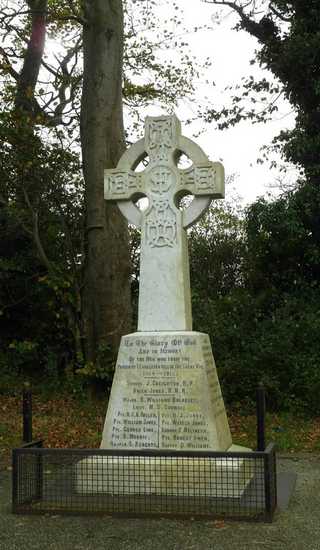
The Memorial outside the Village Hall
Great War 1914 – 1918
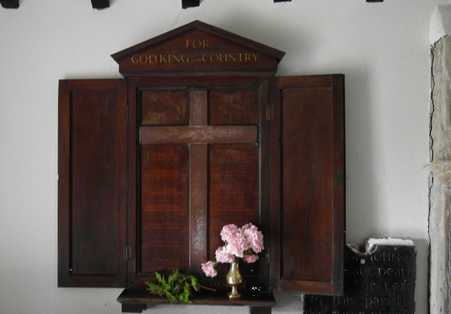
The shrine in the porch of the church of St Tegfan, Llandegfan
Llandegfan War Memorial Summary WWI and WWII
There are 14 men remembered on the War Memorial outside Llandegfan Village Hall; 13 on this shrine (Lieut M. S. Schwabe is not remembered).
This list also includes four men who are named in the churchyard of St Tegfan - two are commemorated on family graves; one died too late to be a war casualty and one had an interesting military career.
1 – Stoker. J. Creighton, R.N.
Stoker John Creighton, 6606S, Royal Naval Reserve, drowned when HMS Indefatigable sank at the Battle of Jutland on Wednesday 31st May 1916; age 21; commemorated on Portsmouth Naval Memorial, and on family headstone in churchyard of St Tegfan, Llandegfan. Also listed as Christopher Creighton and John Craghton
2 – Owen Jones, R.N.R.
Petty Officer Owen Jones 1748D was a career man in the Royal Navy; son of Margaret and Owen Jones of Crossing Terrace, Llanfairpwll; married to Grace Jones of 22 Dale Street, Menai Bridge; killed in action when HMS Invincible was sunk by her own magazine exploding at the Battle of Jutland, Wednesday 31st May 1916; age 45; commemorated on Portsmouth Naval Memorial Llandegfan War Memorial Summary WWI – 3
3 – Major. R. Williams Bulkeley,
Major Richard Gerard Wellesley Williams-Bulkeley, Grenadier Guards until February 1915 when he joined the newly inaugurated Welsh Guards; son of Lady Magdalen and Sir Richard Henry Williams-Bulkeley of Baron Hill, Beaumaris; husband of Victoria Alexandrina Stella Williams-Bulkeley; father of 3 children; wounded in action, sent back for home duties and died Thursday 28th March 1918 at a London Nursing Home; age 31; buried East Finchley cemetery London, also commemorated by East window in church of St Mary & St Nicholas, Beaumaris
4 – Lieut. M. S. Schwabe,
Lieutenant Maurice Salis Schwabe, served as Maurice Shaw; brought up in Middleton Manchester; Glyn Garth, built by his grandfather, was the family holiday home and later the Bishop’s Palace; educated Marlborough College; volunteered with the Highland Light Infantry, Transport Officer; possibly shot by German Prisoners of War who mistook him for a traitor (he spoke fluent German), died on Thursday 30th September 1915; age 44; buried Le Tréport Cemetery, France. His Aunt lived at Garth y Don, Llandegfan and probably asked for him to be named on the War Memorial.
5 – Pte. H. S. H. Fuller,
Private Harry Stephen Hugh Fuller, born in Enfield Lock Middlesex, moved to Llandegfan to live with his grandparents; a baker by trade; married to Mabel Madeline Jones and lived at 19 Mason Street Bangor; first served with the Army Service Corps, later Private 29316 7th Battalion East Yorkshire Regiment; killed in action Sunday 31st March 1918; age 29; buried in Bouzincourt Ridge Cemetery, France
6 – Pte. H. J. Jones,
Private Hugh John Jones 20583 14th Battalion, Royal Welsh Fusiliers, born Criccieth, lived at Bryn Teg Llandegfan; killed in action Friday 24th December, 1915; age 22 (the same day as his brother died, Private Robert Evan Jones 20432, also 14th Battalion RWF); buried Rue-du-Bacquerot (13th London) Graveyard, France
7 – Pte. William Jones,
Private William Jones 25965 17th Battalion, Royal Welsh Fusiliers; lived at Penmon (or Penmaen) Llandegfan; died of pneumonia whilst in training camp in Llandudno on Sunday 30th May 1915; age 34; buried in the churchyard of St Tegfan, Llandegfan (CWGC commemoration, private headstone)
8 - Pte. Walter Jones,
Private Walter Jones 20932 14th Battalion, Royal Welsh Fusiliers; adopted son of Mrs G Jones, lived at Penrorsedd Llandegfan; killed in action at the Battle of Mametz Wood Monday 10th July 1916; age 24; commemorated on the Thiepval Memorial and on family headstone at Capel Barachia, Llandegfan
9 – Pte. George Line,
Private George Line 39182 9th Battalion, Royal Welsh Fusiliers; son of Elizabeth and William
Pennington Line, born in Kendal Westmoreland, enlisted in Menai Bridge; killed in action at Ypres on Sunday 4th November 1917; age 29; buried Bus House Cemetery, Belgium. Also listed as George Lyne
10 – Gunner. E. Molyneux,
Gunner Edward Molyneux 310537 144th Heavy Battery, Royal Garrison Artillery; eldest son of Mr E Molyneux of Brynteg Terrace, Llandegfan; worked at Penrhyn Castle Gardens; died on Sunday 18th November 1917 of wounds received on 16th November; age 20; buried Tincourt New British Cemetery, Somme, France and remembered on the family headstone in churchyard of St Tegfan, Llandegfan, Llandegfan War Memorial Summary WWI – 4
11 – Pte. D. Morris,
Private Daniel Morris 22175 20th Battalion, The King’s (Liverpool) Regiment; born in Llandegfan, family lived at Cae’r Ffynnon Llandegfan, enlisted in Liverpool where he probably worked; was reported missing at the Battle of the Somme, later declared killed in action Sunday 10th July 1916; commemorated on Thiepval Memorial and on family headstone in churchyard of St Tegfan, Llandegfan
12 – Pte. Robert Owen,
Private Robert Owen 49013 17th Battalion, Royal Welsh Fusiliers; born Llandegfan, family lived at Bryn Cottage Llandegfan, enlisted in Altrincham Cheshire; killed in action Friday 6th September 1918; age 26; commemorated Vis-en-Artois Memorial, France and on family headstone in Capel Barachia, Llandegfan
13 – Sapper G. Roberts,
Sapper George Roberts 146835 12th Field Company, Royal Engineers; born Llandegfan, family lived at Bryniau Duon Llandegfan, married to Mrs Margaret E Roberts of West Lynne, 1 Charlton Street, Llandudno; killed in action Thursday 6th September 1917; age 29; buried Philosophe British Cemetery, France; also remembered on family headstone in churchyard of St Tegfan, Llandegfan
14 – Sapper D. Williams
Driver David Williams 63045 Signal Department, Royal Engineers; son of William Williams, family lived at Penlon Llandegfan (later Tynlon Bach); accidentally wounded in the trenches when his pick hit a bomb, evacuated to Eastern General Hospital in Cambridge where he died on Saturday 13th May 1916; age 29; buried churchyard of St Tegfan, Llandegfan (CWGC commemoration, private headstone).
Not on the War Memorial:
15 - John William Meredith, Private 3543 Australian Infantry; son of Mary Ann and John William Meredith (Meredydd) of Castellior; killed in action Thursday 20.09.1917; age 25; commemorated on Menin Gate in Ypres, War Memorial plaque in Church of St Sadwrn Llansadwrn, Cenotaph on St Tysilio in Menai Bridge & family grave in churchyard of St Tegfan, Llandegfan
16 - Harold Madoc Jones, Lieutenant Royal Welsh Fusiliers 17th Battalion; son of the late John Robert of Bodfeirig and Eunice Martha Jones; parents lived at Bryn Cadnant, Llandegfan; educated Christ College Brecon and University College of Wales Aberystwyth; a teacher; twice Mentioned in Despatches; killed in action Tuesday 31st July 1917; age 38; commemorated on Menin Gate at Ypres, Christ College Brecon, Aberystwyth University, Wraysbury War Memorial in Berkshire & family grave in churchyard of St Tegfan, Llandegfan
17 - Eleazer Llewelyn Jones, not an official war casualty; Welsh Regiment; died October 27 1925; age 34; buried in family grave in churchyard of St Tegfan, Llandegfan
18 – Wilfred Henry Cullen Pery-Knox-Gore, not a war casualty; 2nd Lieutenant Royal Anglesey, Royal Engineers; served with Royal Welsh Fusiliers 1914 – 18, becoming Major; later Lieutenant-Colonel Royal Tank Corps, retired 1st February 1925; buried in family grave in churchyard of St Tegfan, Llandegfan
Second World War casualties on the War Memorial:
19 - Major G. E. Gresty, R.W.F.
George Edgar Gresty, Major 85107 6th Battalion Royal Welch Fusiliers; educated Rossall School, Fleetwood in Lancashire; son of John Edgar and Margaret Gresty of Menai Bridge; killed in action 18th July 1944, age 24 after D Day Landings; commemorated Bayeux Memorial, France; Church of St Mary in Menai Bridge & Cenotaph St Tysilio, Menai Bridge
20 – Pte. Moses Parry, 1 Welch
Private Moses Parry 396725, 1st Battalion Welch Regiment; killed in action 23rd May 1941 in Greece, buried Suda Bay Military Cemetery on Crete; commemorated on his brother’s grave in Capel Barachia, Llandegfan
21 – C.P.T.R. Harry Griffiths M.N.
Henry Griffiths, Merchant Navy Carpenter, SS Biela; she was chased by a U-boat, hit by torpedoes and sunk on 15th February 1942; all hands lost; commemorated on Tower Hill Memorial, churchyard of St Tegfan, Llandegfan
22 – G.N.R. Roy Evans, R.N.
Roy Vivian Evans P/JX 248532 Acting Able Seaman, Royal Navy, HMS President III (MV Fort Richepanse); son of Mr & Mrs Owen Evans, husband of Lucy Wynne Evans of Bolton in Lancashire; killed 25th May 1941, age 28; commemorated Portsmouth Naval Memorial, St Tysilio Cenotaph in Menai Bridge; Church of St Mary in Menai Bridge.
Book Review
In the Centennial Footsteps of the Great War
From Sarajevo to Versailles
Attila Szalay-Berezeviczy
MCC Press, 2022, £64.50
This is a heavyweight tome of some 400 pages, written by a Hungarian gentleman who clearly has some very powerful connections, eg it was launched in the UK at a reception in the Hungarian Embassy in London. The book is only available from the publishers in Budapest, and I should add that it covers 1914 and 1915. There is a second volume that covers the rest of the war.
So, what is this book about and what is the interest to WWI enthusiasts? Well, to my mind the be all and end all of this book is the photographs, taken by the author. Yes, there is text but really it only exists to put the photographs in context. The book does deal with the Western Front but I would suggest that the interest to those of us in Western Europe is the photographs, and explanations thereof, dealing with the war in Eastern Europe and beyond. The author has travelled far and wide to produce photographs of the relevant sites, and has many photographs of re-enactments and commemorations. There are, for example, photographs of the Armenian commemoration of the Armenian genocide, and of the memorial in South West Africa where hostilities ceased.
Of the war in the East, one example is the Gorlice-Tarnow offensive in Western Galicia, then part of Austro-Hungary and today part of Eastern Poland. These battles are detailed in Alexander Watson’s book The Fortress (the fortress being the fortress complex of Przemsyl).
In the current book, the key point is the traces left today, such as the 400 WWI cemeteries in Western Galicia. Unlike those on the Western Front, they are very varied in their design. The Austro-Hungarian grave markers, for example, are usually crosses with a “pitched roof” over the top of the cross.
So, if you are interested in photographs of WWI, and especially if you are interested in the Eastern Fronts and indeed the Middle East, Asia and Africa, you will find this book fascinating.
Gorlice-Tarnow offensive in Western Galicia (Austro-Hungary and Russia) 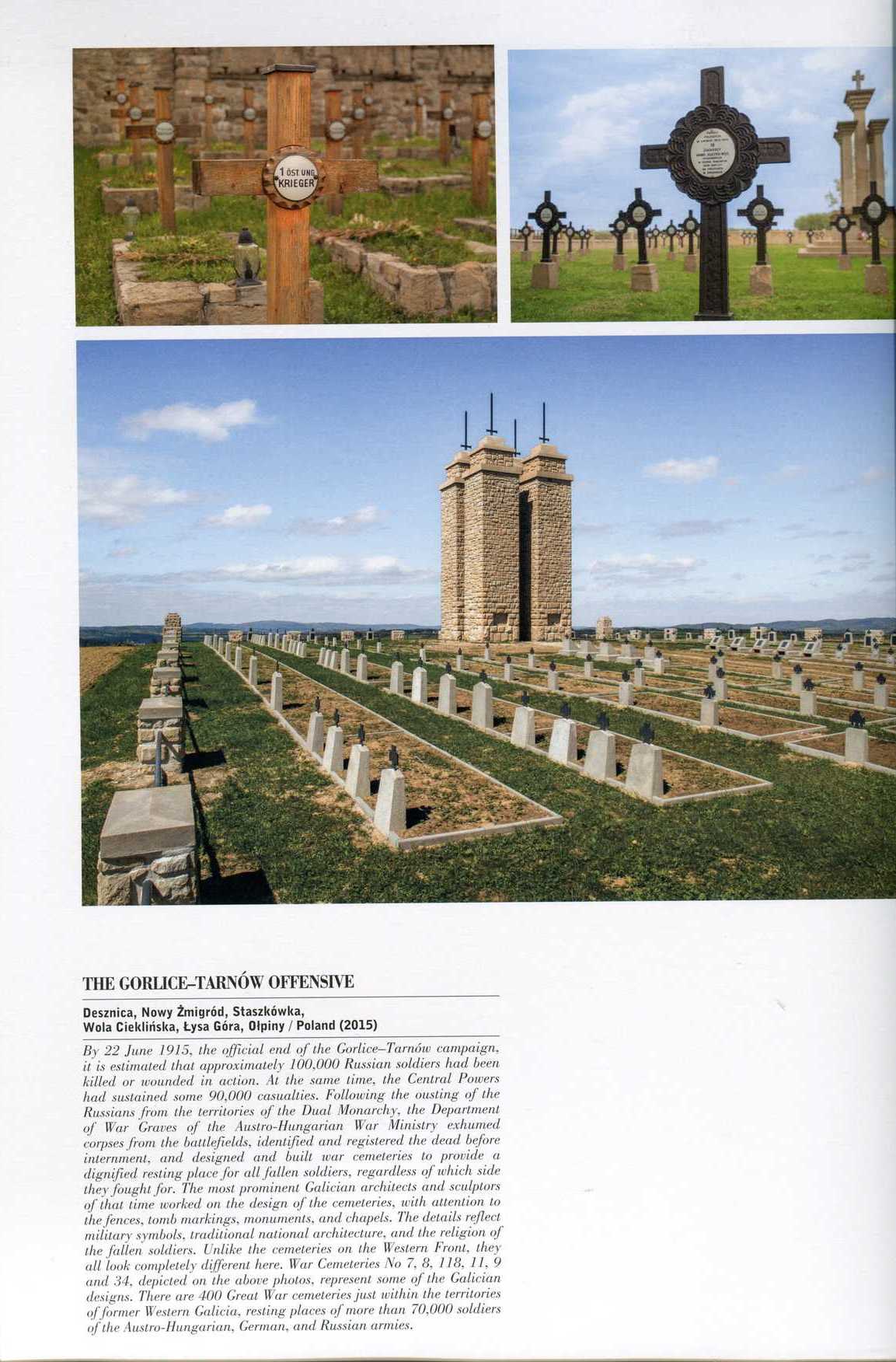
By June 1915, the Russians had sustained 100,000 casualties by the end of the Gorlice-Tarnow campaign, and the Central Powers some 90,000.
Austro-Hungary constructed some 400 cemeteries within western Galicia, today eastern Poland, but they are varied in design.
Western Galicia cemeteries (Eastern Poland today)
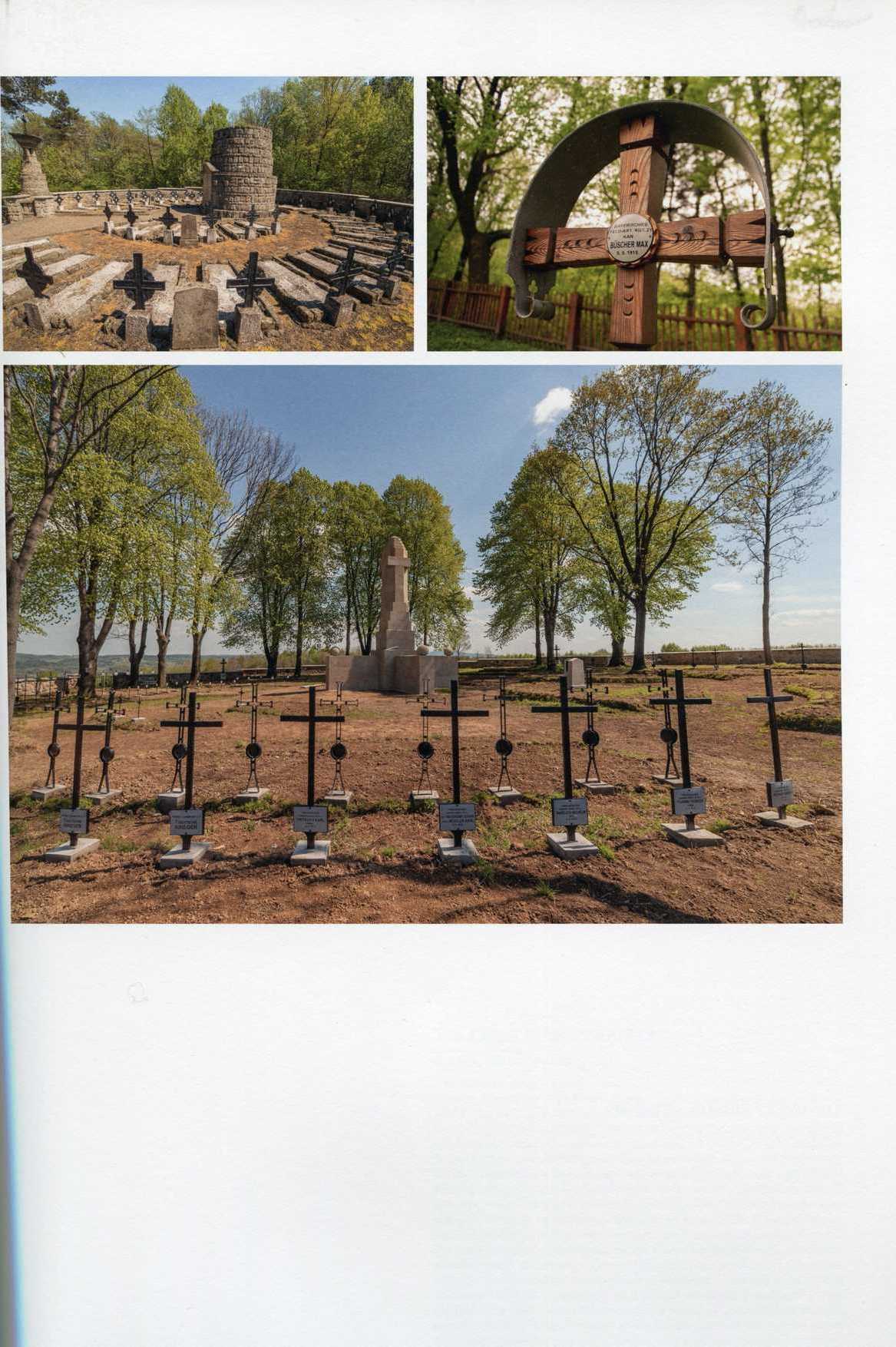
The Carpathian campaigns (Austro-Hungary and Russia) –Usok Pass
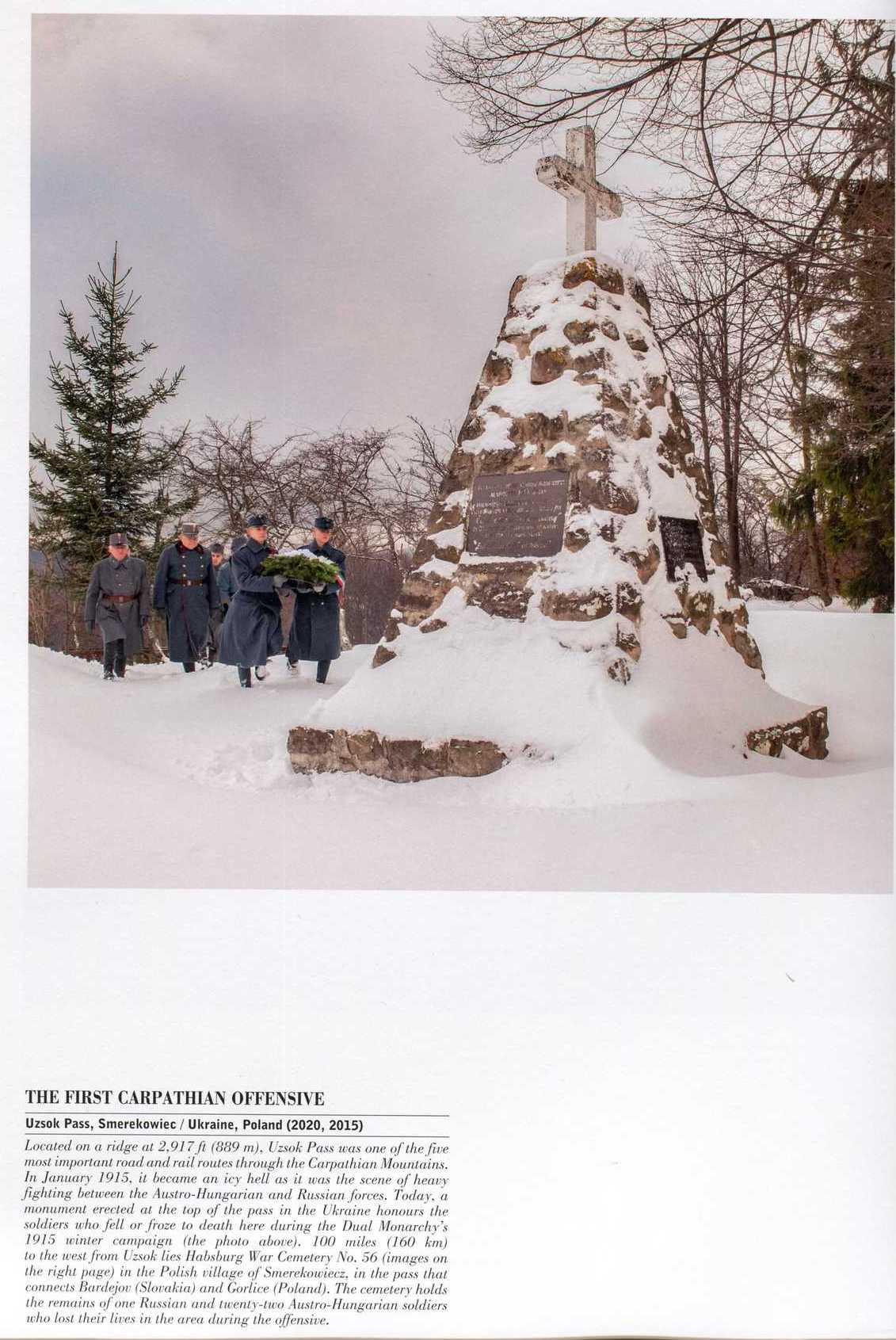
The memorial is at the top of the Usok Pass, today in the Ukraine. It is at 2917 feet. The battle was in January 1915, in atrocious conditions.
Carpathian campaigns 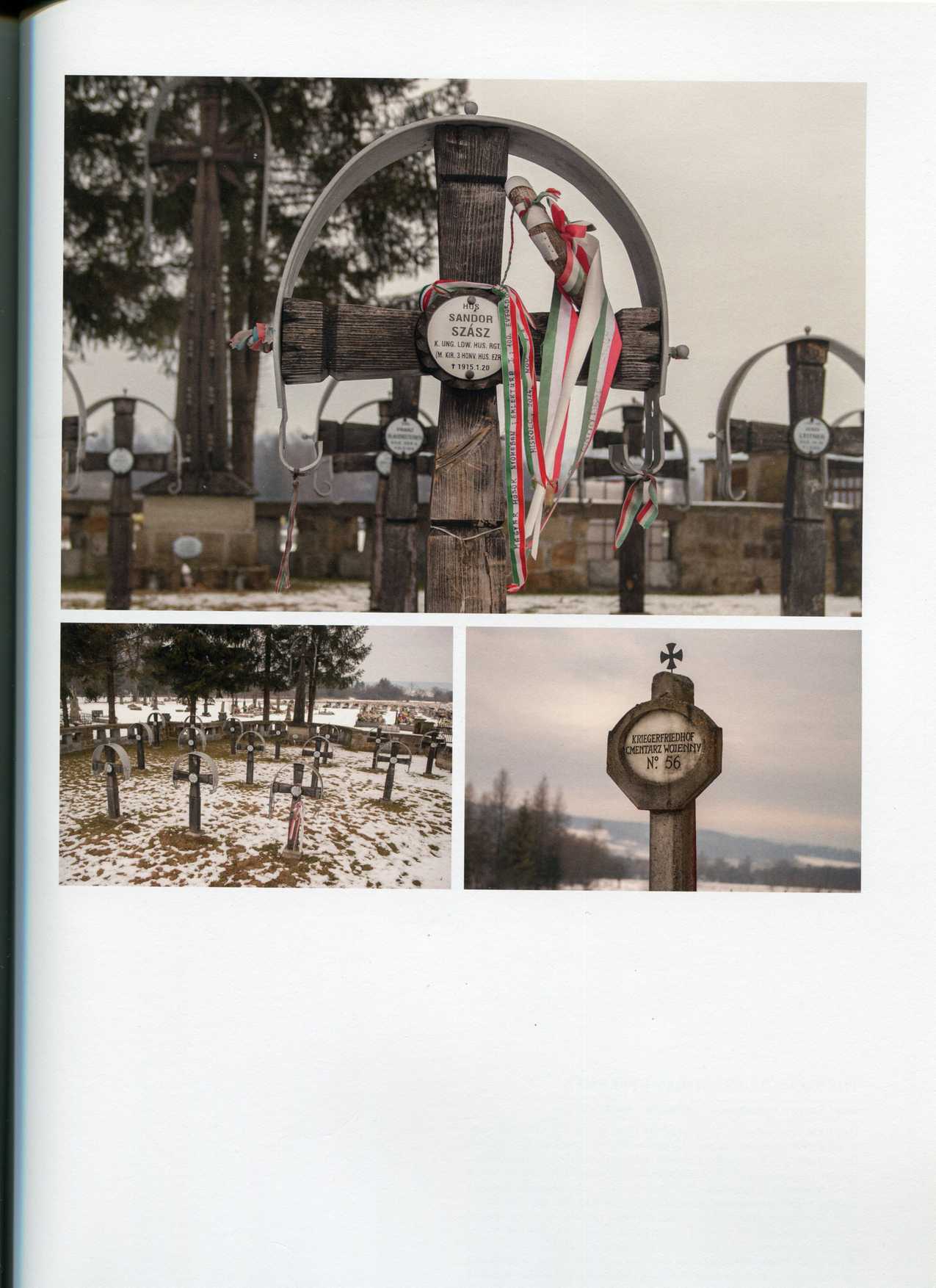
This cemetery lies 100 miles to the west of the Uzok pass. It is located in a pass that connects Gorlice, today in Poland, with Bardejov, today in Slovakia.
Red, white and green are the Hungarian national colours
Carpathian campaigns
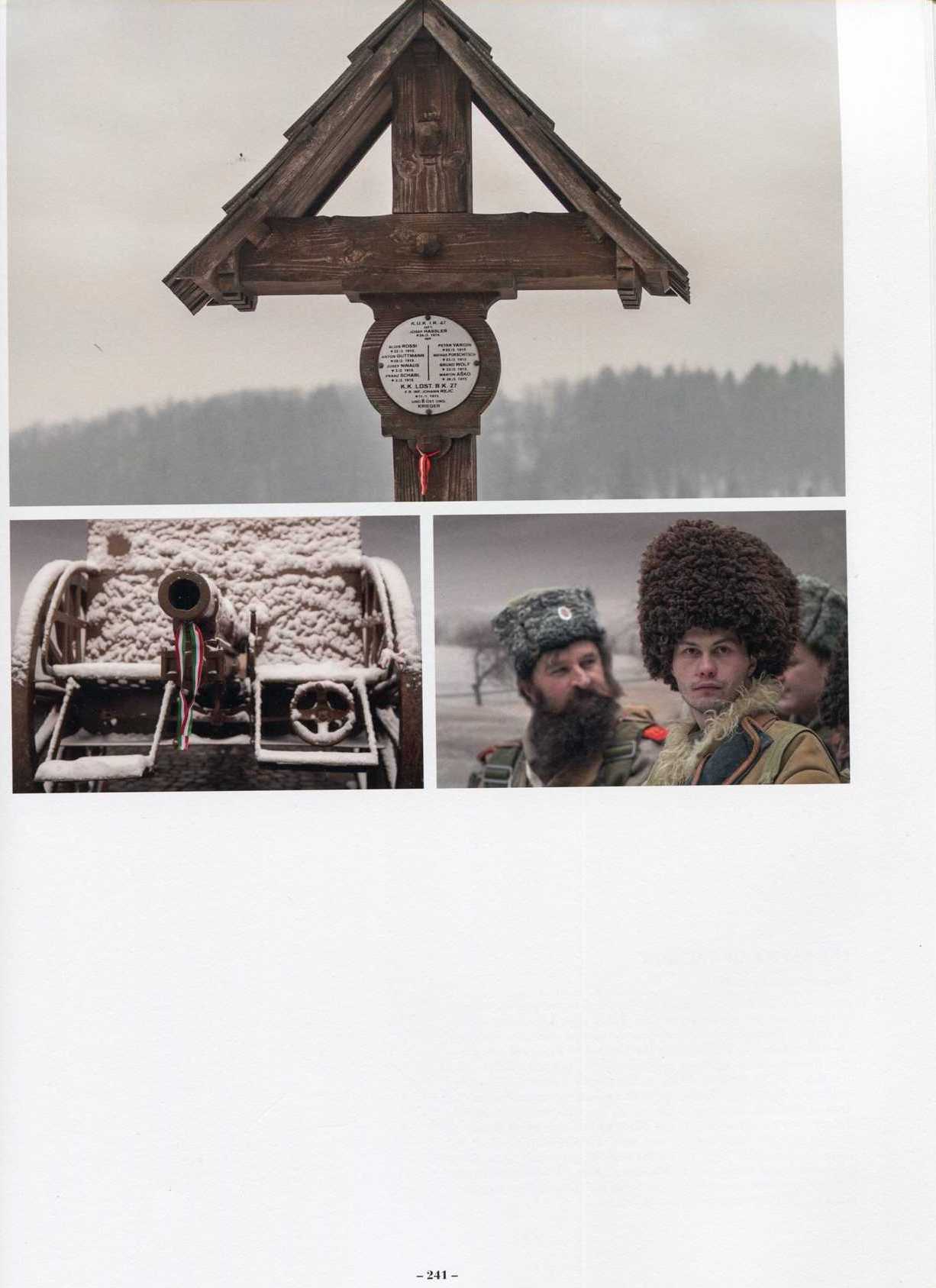
German South West Africa (Namibia) (South Africans and German forces)
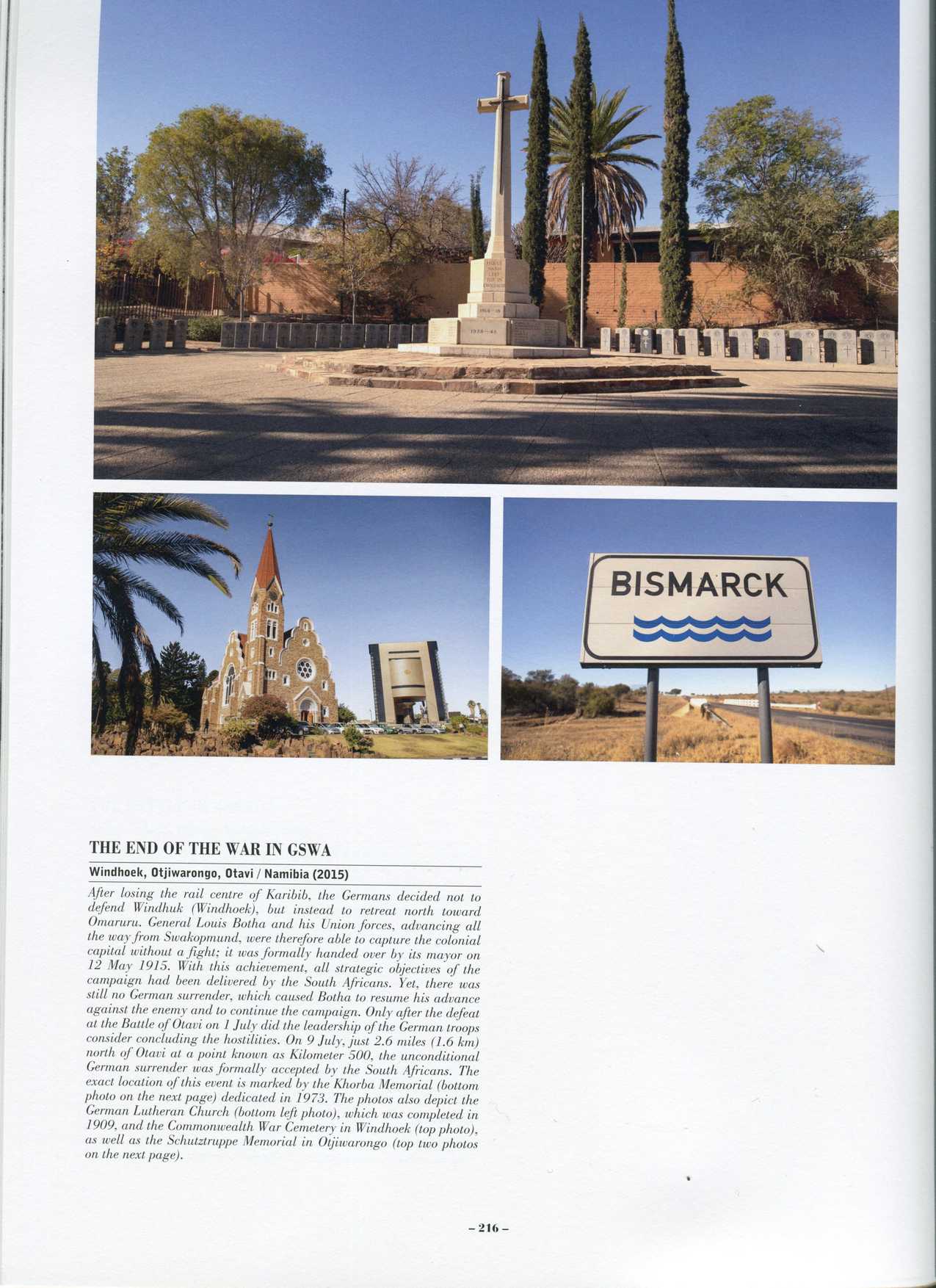
The campaign here ended with the defeat of the German forces, largely native troops, at the Battle of Otavi on 1st July 1915.
The German forces had not attempted to defend the capital Windhoek, so the South Afrcians under Louis Botha captured it without a fight.
The CWGC cemetery is at Windhoek (Namibia).
The church is a German Lutheran church built in 1909.
German South West Africa
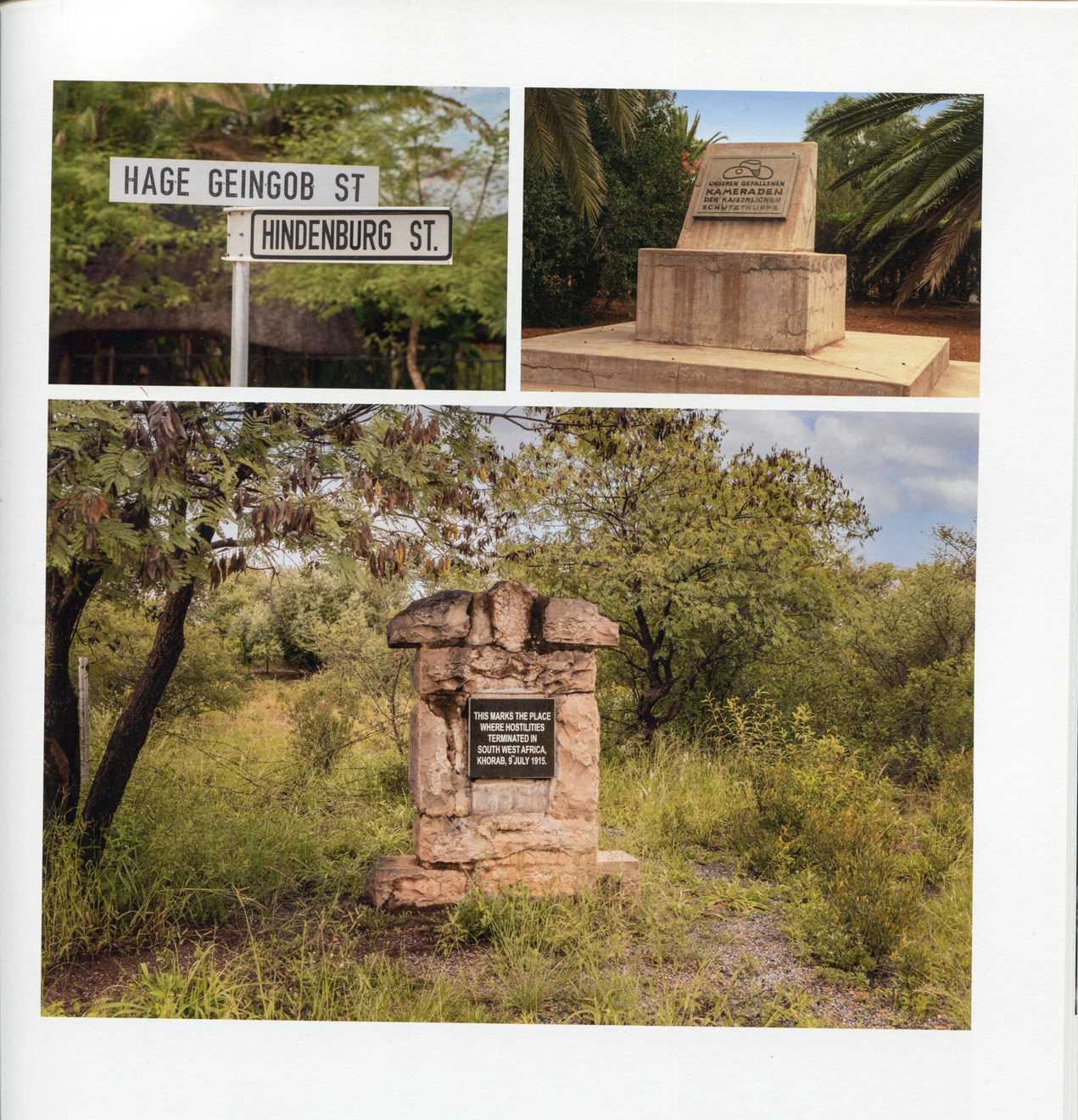
The Khorab memorial (bottom centre) marks the location of the surrender of German forces in South West Africa, 9th July 1915.
The Schutztruppe memorial (top right) is to German native African soldiers.
The Caucasus (Ottomans and Russia) 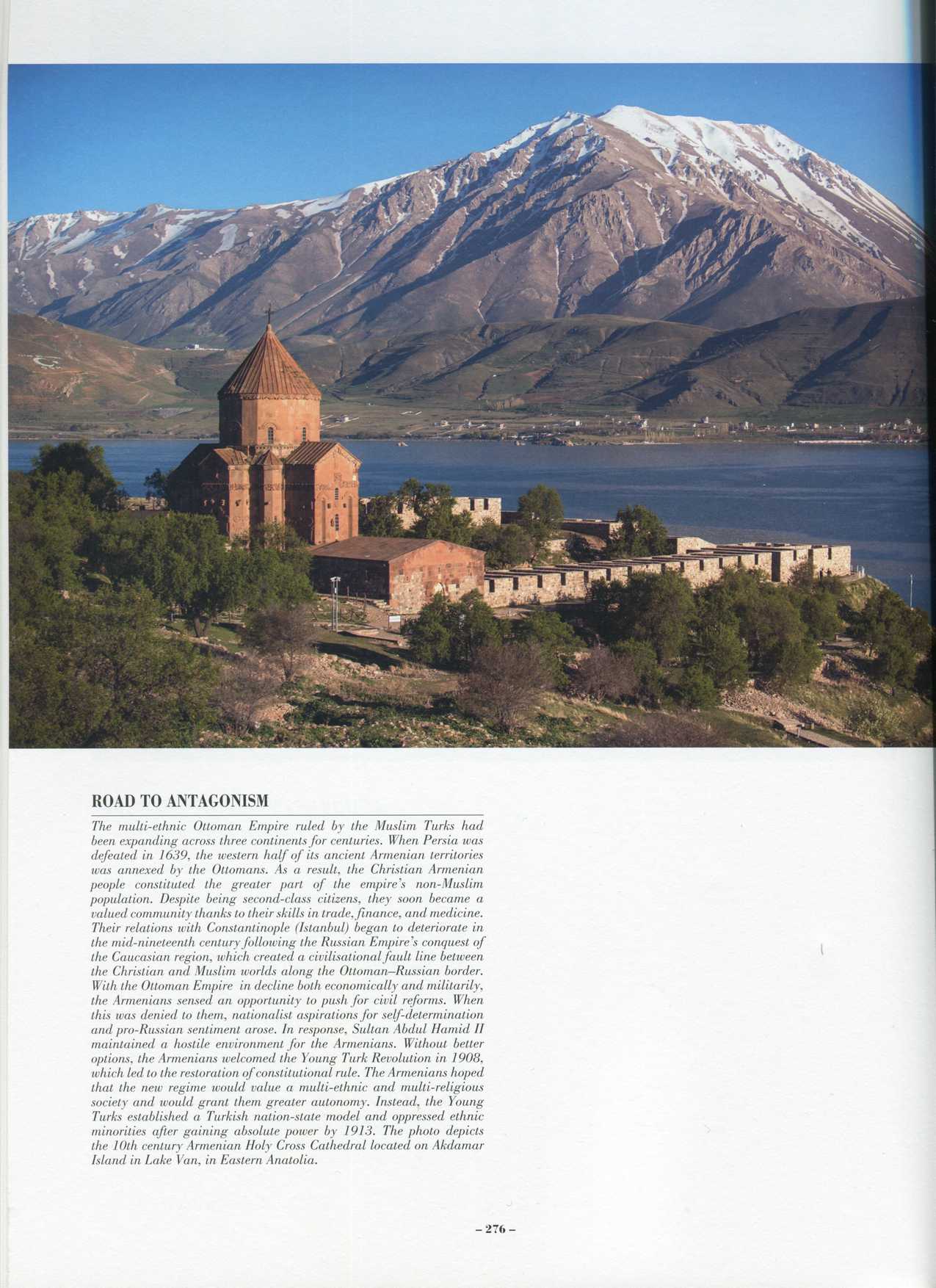
Lake Van and the Armenian cathedral, which are today in Turkey, not Armenia. It seems very unlikely that there is any Armenian population in the area now.
The Caucasus – the Trebizond (Trabzon) campaign
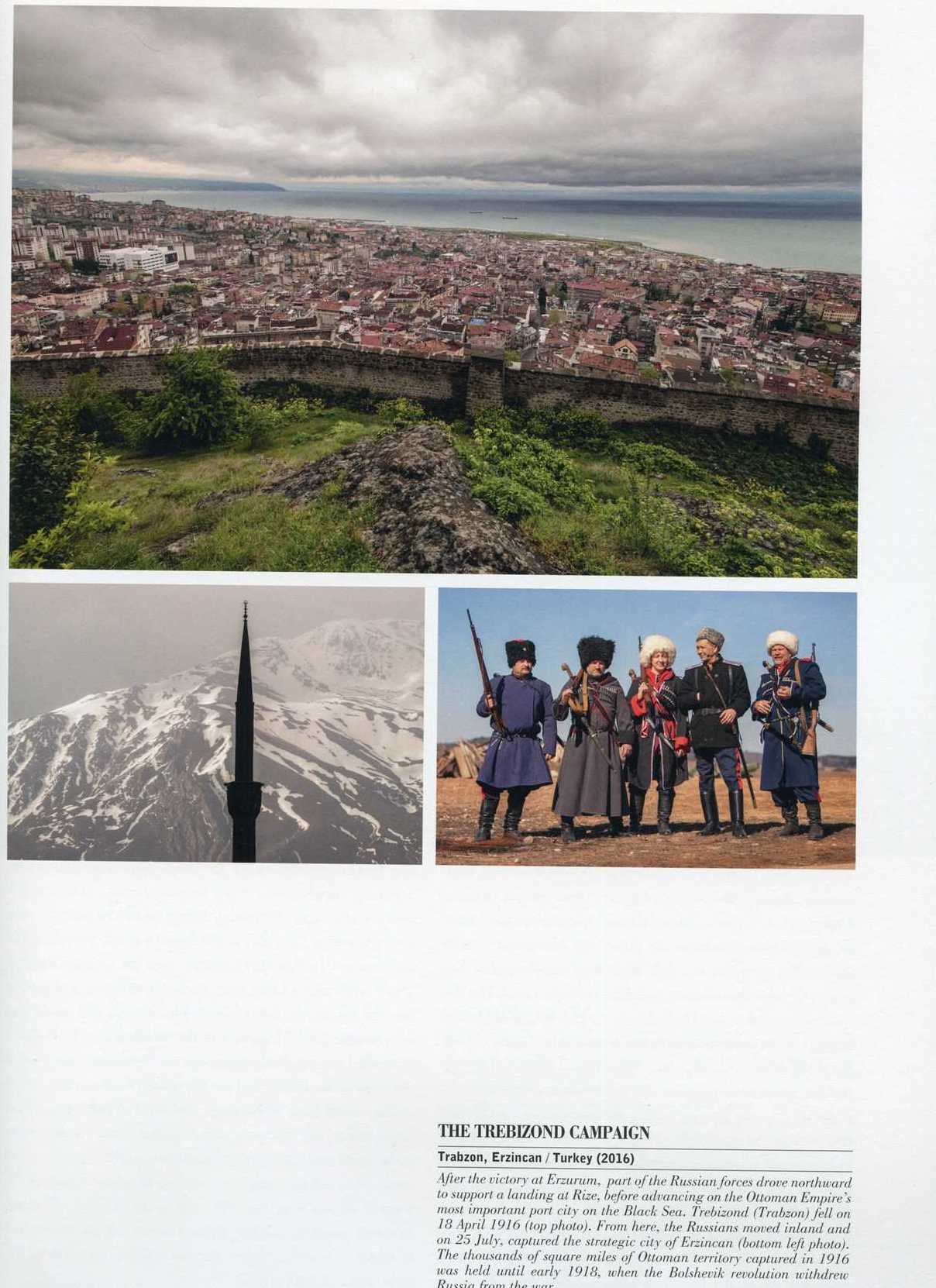 After their victory at Erzurum, see below, Russia captured thousands of square miles of Ottoman territory and the Black Sea port of Trebizond (top photo).
After their victory at Erzurum, see below, Russia captured thousands of square miles of Ottoman territory and the Black Sea port of Trebizond (top photo).
From there, they moved inland and captured the strategic city of Erzincan.
The Caucasus - The Russians attack Erzurum in January 1916

In January 1916, the Russians attacked the fortress city of Erzurum, which the Ottomans believed to be impregnable, and took it on 16th February 1916.